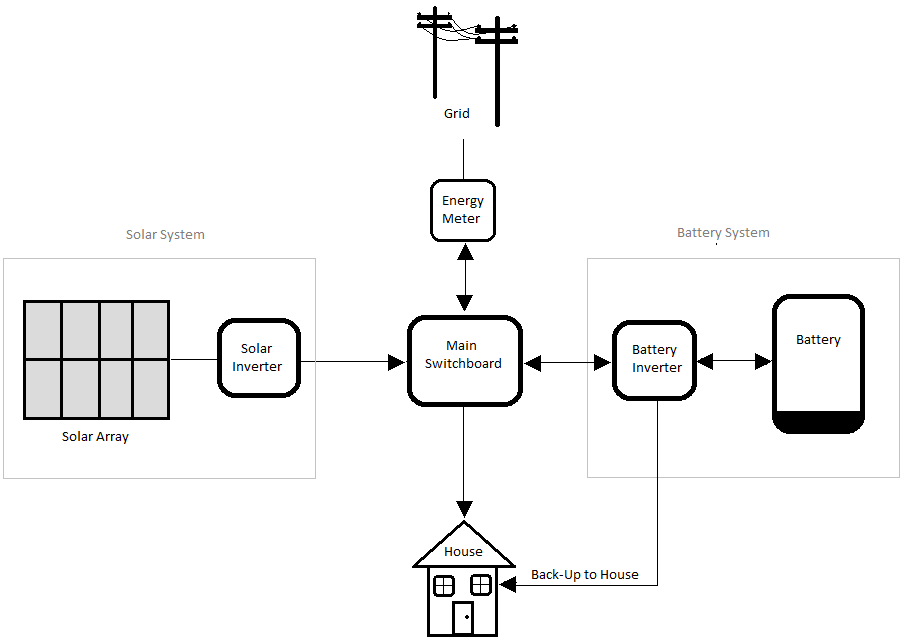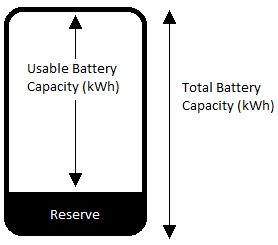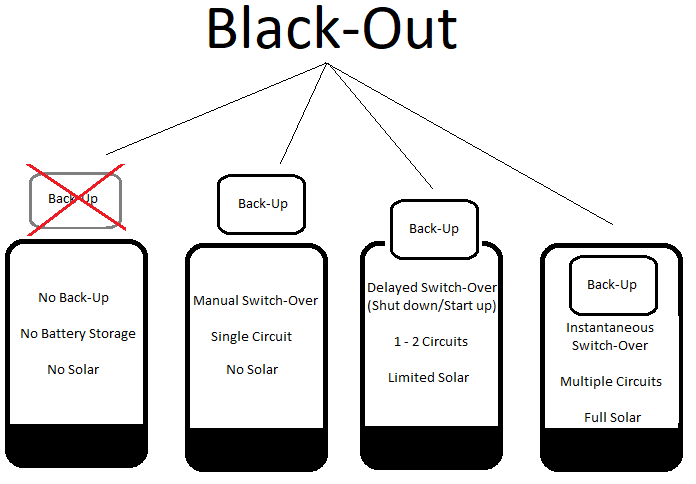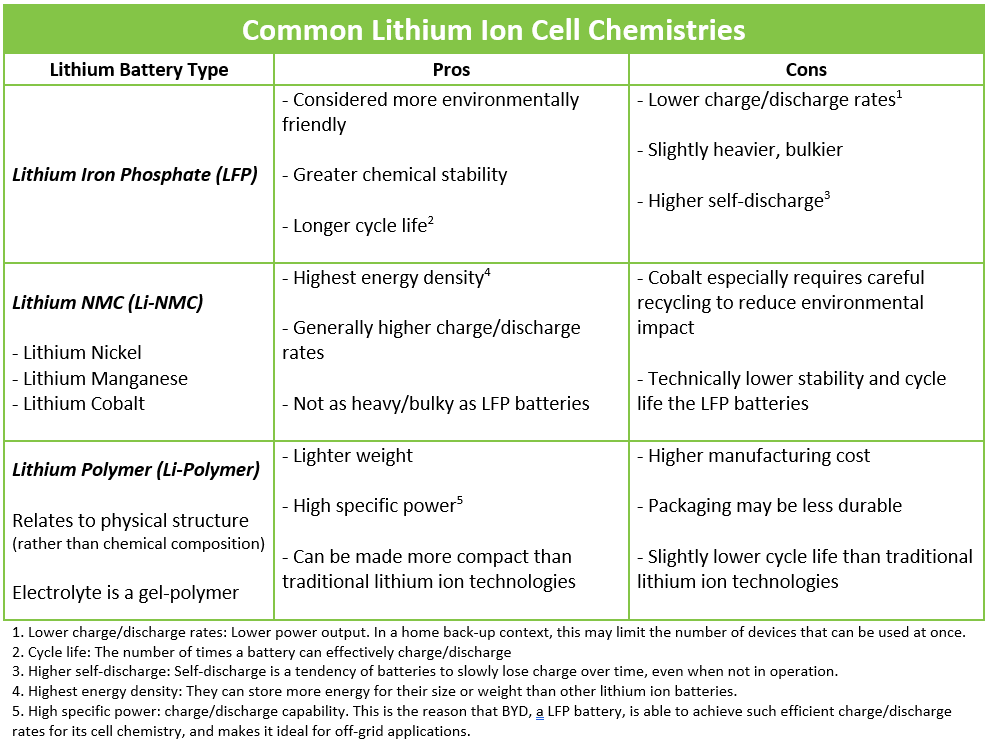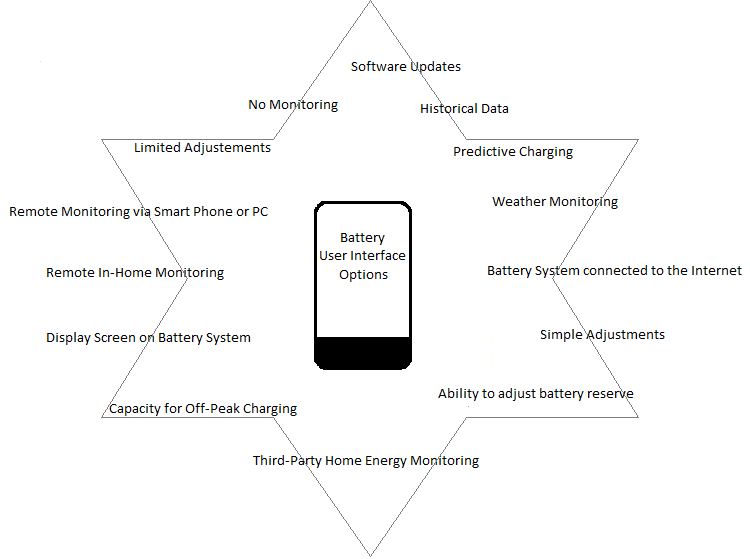Solar Battery Storage – Getting it Right
26 Apr, 2019
Don’t be carried away with the glamour of having battery storage, just for the sake of having battery storage.
Having a battery doesn’t automatically mean you can laugh at grid outages, capture all your solar energy, or end up with a $0.00 power bill.
It all depends.
Despite the Utopian expectations cultivated by misleading marketing, you’ll often be better off not installing a battery at all, rather than installing a battery that won’t match your power requirements and expectations.
Cost alone is NOT a reliable indication of quality &/or performance.
You’ll need to do some homework to ensure you get genuine value-for-money.
Overview: How Solar Battery Storage Works
How do you determine if battery storage is right for you – and which one is best?
It’s helpful if you have a clear idea of exactly why you are wanting to install a battery.
This helps determine whether it’s really worth taking the plunge, and to narrow the field on your options if you do.
For example, do you want to:
- Make the most of your solar generation?
- Optimise your independence from the grid?
- Store enough power to get you through the night?
- Have your own renewable power source?
- Have the assurance of a source of back-up power?
- Maximise return-on-investment?
- Keep up with ‘dem Joneses?
- All of the above?
Side-stepping all the branding, here’s what to look at in Battery Storage:
1. Available Energy (Battery Size)
Battery size is generally stated as kilowatt hours (kWh) – the amount of energy a battery is capable of storing.
Each battery has two significant size constraints:
- Total/Rated/Nominal Storage: The theoretical (‘rated’) maximum storage capacity
- Useable Storage (% Depth-of-Discharge): The maximum amount of energy that you are practically able to use. The remainder, though an integral part of design to help maintain battery life, has no practical benefit for you.
The proportion of usable vs. total energy varies significantly from battery to battery, so when comparing batteries it’s helpful to know the usable storage capacity of each model.
2. Power (Battery Inverter Capacity)
Energy flows in and out of a battery through a Battery Inverter. Datasheets refer to this power flow as either ‘charge/discharge’, or ‘input/output’.
Some batteries come with an in-built battery inverter; others need to be installed with a separate battery inverter.
Where a battery inverter is installed separately:
- Check the charge/discharge capacity of each different compatible battery inverter option, as this can vary between brands and models
- Be aware that the charge/discharge capacity of the battery can differ from the charge/discharge capacity of the battery inverter. You will be limited to whichever is the lowest.
Maximum charge/discharge rate is the limiting factor in determining how much power a battery can deliver at any one time. It determines what you can actually do with your stored energy.
This is an important factor to consider when looking at battery options, as you’ll want to have a battery system that is able to deliver the amount of power you require, when you require it.
3. Back-Up
Having a battery does NOT automatically mean you’ll have power when the grid goes down.
Not all batteries come with back-up.
Where it does, the nature and extent of ‘back-up’ may vary widely between brands.
When looking at battery options, you need to consider:
- Is backup available with this battery?
- Where available, is back-up included as standard, or an optional extra?
- If an optional extra, how much will it cost to add it to the battery system?
- What exactly is the back-up function capable of doing?
- Manual or automatic switch-over in case of grid failure?
- Delayed or Instantaneous switch-over?
- How much power can your battery deliver in backup mode?
- How many power circuits (fuses) can your battery supply in backup mode?
- Can you only draw power from the battery in back-up mode, or can you simultaneously use both your solar PV and battery storage?
If you want a battery that is able to run in back-up mode when the grid is down, you’ll need to consider how much power you will require. Just enough to keep the fridge/freezer and lights running – or do you need to be able to boil the kettle for a cup of tea, too? See our Average Energy Usage Guide for an idea of how much power common appliances require to run.
Your back-up priorities will play a significant role in determining which battery is right for you.
4. Battery Technology
The technology of a battery – its physical and chemical composition – will play a role in factors such as safety, maximum possible charge/discharge rates, battery life, and even the physical size and weight of the battery.
There are a wide range of different solar battery storage technologies currently being marketed, including:
- Lead Acid
- Lithium Ion
- Zinc-Bromide or Vanadium-Redox Flow
- Salt-Water
- Super Capacitors
Each technology comes with various pros and cons.
The most common technology for home grid-connected solar battery storage is currently Lithium Ion. Even within this specific technology there are a number of variations in the chemistry and physical composition in the battery:
Cell chemistry is commonly used as a selling point.
It’s important to realise that no single cell chemistry is ‘the best’. Each chemistry has particular benefits and limitations.
It’s also important to appreciate that cell chemistry alone is no guarantee of quality and safety.
The quality of materials used, physical design technology, and manufacturing process will also play a significant role.
Details on this information is not always readily accessible. Associated information such as warranty length & conditions, and Manufacturer reputation/identity, may provide a general indication of likely product reliability.
Keeping this in mind when looking at different battery options may help you evaluate marketing claims for different batteries more objectively.
5. Warranty
The warranty associated with a battery can have significant financial & practical implications.
When looking at battery storage, consider:
The Warranty Period
The warranty period of storage batteries is often expressed as either:
- a specific period of time, and/or
- a maximum amount of ‘warranted cycles’ (or, more accurately, ‘warranted energy throughput’ – the total kWh supplied by the battery over time)
Some manufacturers simply set the warranty period as a set time with no reference to warranted energy throughput.
Others set the warranty period as either a set period of time, or a set amount of warranted energy throughput – whichever comes first. In this case, it’s worth considering your proposed battery usage and what impact this will have on the warranty.
Most Lithium-Ion Batteries in the market have a warranty period of 10 years.
The Warranted Performance
The storage capacity of batteries lessens over time.
Battery manufacturers should provide a warranty on the amount (percentage) of usable storage that their battery will retain for the duration of the warranty period. This may be expressed as ‘energy retention’, ‘capacity retention’, or other similar term.
The percentage of usable battery capacity at the end of a warranted period varies dramatically between battery brands (commonly between 60 – 80%).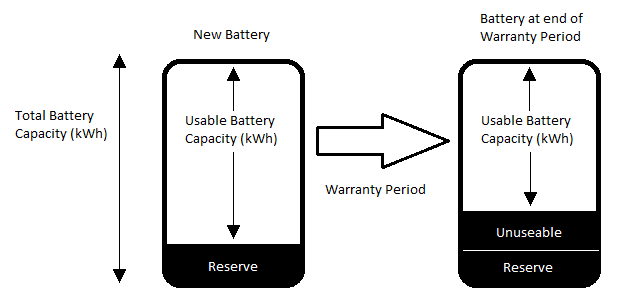
This practically reflects how much storage capacity you will actually have available for use over time.
Limitations & Exclusions
Warranty Terms & Conditions can be specific to each country of installation. It’s worth being familiar with these conditions to ensure that you would be reasonably able to meet the stated requirements for the warranty to remain valid.
Be aware that no warranty on any product sold in Australia is able to exclude, restrict, or limit your rights as a customer under Australian Consumer Law.
6. User Interface: Software & Monitoring
Once you have installed a battery, how do you know that it’s working?
How do you adjust – can you adjust? – any settings for battery management and use?
This aspect of the battery system is rarely given the consideration it deserves.
Options differ hugely between battery brands, literally ranging from the a purely physical battery system with no monitoring or capacity for modification at all, right through to sophisticated systems incorporating predictive app-based software with remote management capacity.
Understand exactly what a battery system is capable of in terms of monitoring, adjustments, and updates (if any). This will go a long way to avoiding disappointment at a later date.
Other Important Considerations
7. Solar Capacity
Do you have enough solar to adequately charge your battery?
It’s important that your battery storage capacity is compatible with your solar generation capacity. This is especially significant during Winter in Tasmania.
There’s no use having a nice (expensive) battery if you can’t charge it.
8. Simplicity of Design Architecture
This is all about the simplicity of battery design, installation, and usage. Consider:
- How easy will it be to integrate the battery into your existing system?
- How many components will need to be installed for your system to work?
- Where will they need to be installed (inside or outside)?
- How many individual components/brands are included in the battery system?
- If there’s an issue, how many manufacturers may be involved?
- How does this impact on warranties?
- Is there any monitoring available? How easy is it to use/navigate/understand?
9. After-Sales Service
Does the manufacturer of the battery you are considering have offices in Australia?
How easy will it be to access any after-sales support? If you have an issue, will you be able to contact someone locally, during regular business hours?
Can the manufacturer diagnose faults remotely?
This isn’t something that’s always considered in the battery storage equation, but can play a huge role in your confidence and satisfaction with your purchase over time.
We at Mode have installed hundreds of different energy systems for over 14 years, and can assure you that the importance of this aspect should not be under-estimated.
10. Manufacturer Bankability
As with any new technology, an explosion in sales is associated with an explosion of companies capitalising on a growing market. Often this is also associated with an equally rapid closure of opportunistic businesses once the ‘boom’ passes.
As a warranty is only as good as the manufacturing Company’s ability to support the warranty, it makes sense that you’d want some degree of confidence that the Company you’re dealing with will be in business long enough to at least support any warranty claims.
Is the manufacturer of your battery a well-established company?
Remember that you’re putting money on the premise that they’ll be there to support you into the future.

